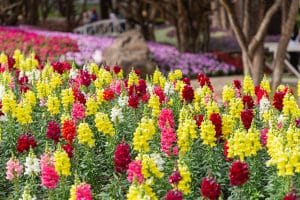How to Start a Flower Garden

Spring is the perfect time to start a flower garden. However, unless you have a green thumb honed with years of gardening experience, you are likely at least a bit intimidated by the prospect of creating a flower garden. Here’s how to do it.
Your Flower Garden Starts With a Plan
Planning is essential to the success of your flower garden. Spend some time thinking about where the flower bed should be placed in the yard. The location of your flower bed will determine the types of flowers you’re able to plant. Once you pinpoint the perfect place for your flower garden, it is time to shift your attention to supplies. You’ll need seeds or small flowers, garden gloves, garden tools (including a soil tiller), knee pads, and plant food. The soil tiller might seem like a minor detail, yet it is a mistake to try to create a flower garden without it. Your soil tiller is essential for loosening the soil in the space where your flower garden will be planted. Additional supplies necessary for a flower garden include mulch and some extra soil.
The Soil Is Particularly Important
Aside from ample sunlight, flowers also need the right soil to reach their true potential. The soil should not be particularly sticky or sandy. The best soil has ample organic matter that allows for draining and is inviting to plant roots. In fact, it makes sense to test the soil’s fertility and pH with an electronic soil tester prior to moving forward. Knowing the pH will let you determine whether you need to add nutrient-rich soil. If this sounds complicated, don’t fret – your local gardening store can help you.
Choose the Right Flowers
There are two primary types of flowers used in gardens: annuals and perennials. Annuals pass through an entire life cycle in a single growing season. These flowers sprout upward from a seed, grow their roots and leaves, ultimately generating flowers that create even more seeds. Annuals are favored by gardeners, as their heads bloom all season with the proper care. Alternatively, perennials are plants with root systems that remain alive when under the ground for years or possibly even decades. The part of perennials that is above the soil might go dormant during the winter months yet it will reemerge once spring rolls around. The only downside to long-lasting perennials is they usually bloom for merely a couple of weeks or months per year.
If you want a considerable number of flowers, annuals are the right choice. However, beginning gardeners should be aware that annuals require more care in terms of fertilizing and watering than perennials. Furthermore, planting annuals each year requires considerable effort. If you are looking to add structure to your garden, perennials are the better choice. Perennials are also favored by some gardeners as they don’t require nearly as much care as annuals.
Regardless of whether you choose annuals or perennials, you must choose plants that will do well in the location you’ve chosen. Plants that flourish in the shade just won’t work in full sun, and vice-versa. You’ll save yourself a lot of money and hassle if you choose the right flowers. When buying plants and flowers, look at the description on the pot or seed packet to see which ones do best in various levels of sun exposure and heat.
Choosing Between Seeds and Plants
Perennials and annuals can be sown directly from seeds within the garden, though they take some time to sprout. Annuals require a couple of weeks to sprout, develop, and subsequently bloom, while perennials require upwards of a year for this process. This is why more and more gardeners plant their flower seeds inside the house in the weeks leading up to the spring when it is warm enough to plant them outdoors. The other option is to buy flowers that have already sprouted. If you take this approach, choose flowers that are not currently in bloom, as it is better for the flowers to bloom in the garden as opposed to in a greenhouse.
Planting the Flowers
Now that you have a space designated for your flower garden and have chosen the flowers that will grow within it, it is time to get to work. Dig up the grass and other greenery in the selected area. The tiller will prove quite helpful as you prepare the soil for your flowers. Once all the greenery is out of the way and you have dug up/loosened the soil with the tiller, you’ll likely need to add nutrient-rich soil to ensure your plants are as healthy as possible.
Now that the soil is ready, dig a hole that is two times as deep as the size of the container that the plants are in. Loosen the roots of the plant just prior to placing them in the ground. The logic in this approach is that it makes it that much easier for roots to take within the soil. Use the soil to cover the roots and gently press the flower into the ground below.
Contact Clearfork Lawn Care Today
The landscaping and lawn care specialists at Clearfork Lawn Care are a call away. Our crew will design and install the perfect landscaping for your yard. Reach out to us today to learn more about our services and get a free quote. You can call Clearkfork Lawn Care at 817-705-9352 or fill out our contact form.
